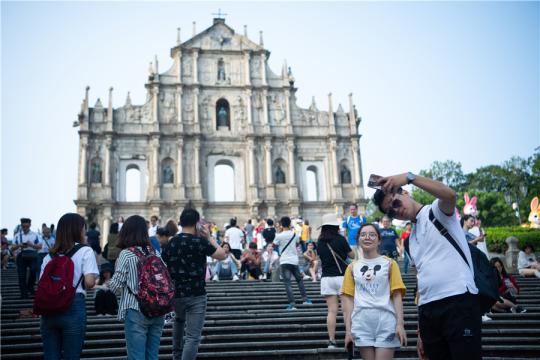Bay Area plan, rising tourist numbers shape Macao's transformation as leisure hub
 0 Comment(s)
0 Comment(s) Print
Print E-mail China Daily, January 14, 2020
E-mail China Daily, January 14, 2020

The Macao Special Administrative Region has witnessed strong growth in both the number of travelers and flights going there and the region in Southern China is closer in its aim to become a global leisure tourism center.
Last year, a record 9.6 million people took flights at Macao International Airport, up 16 percent over the previous year's level. It was the highest growth since 2006, and 14 times higher than the local population.
The travelers mainly came from the Chinese mainland, Southeast Asian and Northeast Asian countries. They accounted for 40 percent of the total, according to Carnoc, one of the largest civil aviation portals in China.
"With a stable social environment, the tourism and gambling sectors in Macao are seeing booming growth prospects. Under the impact of the unrest in Hong Kong, many travelers from the Chinese mainland would prefer to choose its neighboring region Macao," said Lin Zhijie, an aviation industry analyst and a columnist of Carnoc.
"The Macao airport is saturated and it needs to start its expansion project as soon as possible. The area has only one local carrier, Air Macao. If it could introduce a second carrier, it would help to provide more flights options and cheaper prices to passengers," Lin said.
In 2019, more than 77,000 flights took off and landed at the airport, a figure that is 18 percent higher over 2018. Of the total, the number of flights that connected Macao with the Chinese mainland grew 25 percent year-on-year, while flights that connected Macao and Southeast Asian countries increased by 14 percent year-on-year.
In 2019, the Macao airport launched 13 new destinations. It connected Macao with more smaller cities in the Chinese mainland such as Wenzhou in Zhejiang province, Yangzhou and Nantong in Jiangsu province, Shenyang, Liaoning province, and Changsha, Hunan province.
The airport also launched international flights that connected Macao with neighboring foreign cities such as Jeju in the Republic of Korea, Pyongyang in the Democratic People's Republic of Korea, Cam Ranh in Vietnam, and Mandalay, Myanmar.
"The fast economic growth of Macao has attracted a large number of travelers. 2019 was also the 20th anniversary of the former Portuguese colony of Macao returning to China. Macao has added a lot of capacity in its air travel market. It needs to improve the infrastructure to support capacity increase," said Zou Jianjun, a professor of the Civil Aviation Management Institute of China.
With 34 carriers operating at the Macao airport, the airport aims to further grow middle-and long-haul flights this year to attract more local and international passengers to fly or transfer through the territory.
On Feb 18 last year, the outline development plan for the Guangdong-Hong Kong-Macao Greater Bay Area was unveiled by the central government. Macao has developed rapidly and integrated itself into economic globalization through the development strategy.
During the New Year holiday this year on Jan 1, which falls on last Wednesday and people from the Chinese mainland only take one day off from work, the number of travelers who set out on the road to Macao did not drop.
Compared with the New Year holiday last year, those who took trips to Macao this year jumped by 12.1 percent. The largest number of travelers came from Shanghai, Hangzhou and Bangkok, according to Qunar, one of the country's biggest online travel agencies.
In the full year of 2019, Chinese mainland travelers who visited Macao surged by 47.7 percent over 2018. Travelers from Shanghai, Hangzhou and Beijing topped the list of tourists, Qunar said.
In contrast, Chinese mainland travelers who visited Hong Kong last year dropped 4.1 percent over the previous year. During the New Year holiday this year, the number of travelers fell 7 percent year-on-year.
"With convenient location and unique tourism resources, Macao has become a popular flight transfer destination, especially for those who travel from the Chinese mainland to Southeast Asian countries," said Qunar Vice-President Lan Xiang.
"Traveling with children and the elderly has become the fastest-growing groups. Last year, most people traveled to Macao in February and March, which follows the Spring Festival holiday, as well as in August, the summer vacation period," Lan said.
To enjoy some delicious food is now also an essential part of traveling to Macao. Portuguese egg tart, pork chop buns, and crab congee have become some of the most popular dishes.
On Dazhongdianping, a Chinese customer review app similar to Yelp, the number of people who searched about Macao in October last year jumped 31.9 percent year-on-year.
People from Guangdong province, which is the closest to Macao, booked the largest number of hotel rooms last year. With convenient transportation such as the Hong Kong-Zhuhai-Macao Bridge, going to Macao to spend a weekend with the family has become a new way for many travelers from Guangdong to take a short vacation.
In the first 11 months of 2019, cross-border vehicle traffic went up by 9.1 percent year-on-year to 4,893,915 trips, the Statistics and Census Service of Macao said.
Overall, the number of hotel bookings in Macao last year soared 61 percent over 2018.
On the other hand, residents living in Macao would like to take trips to Shanghai, Hangzhou and Taipei as their travel destinations, Qunar said.






Go to Forum >>0 Comment(s)